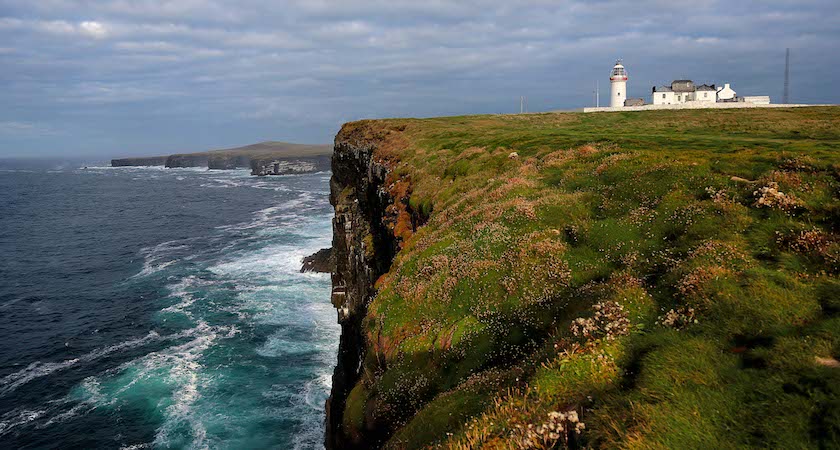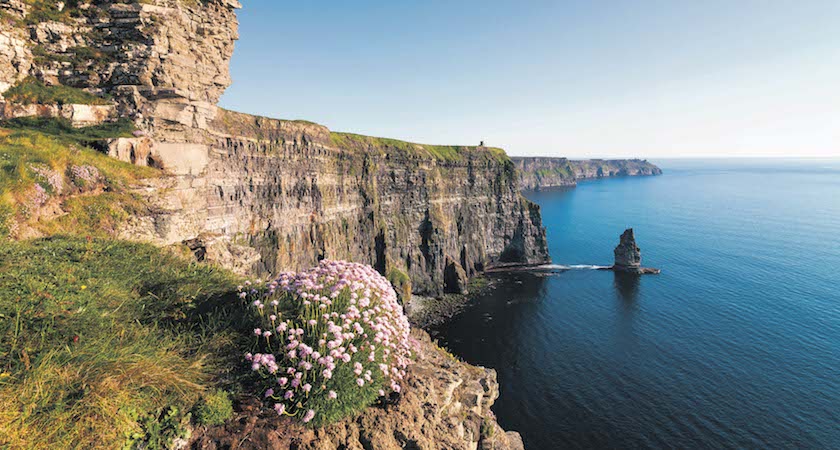DANCING, singing in pubs till all hours, and craic that probably contravenes not just local licensing laws, but the Geneva Convention as well.
You’ll get all that on the Wild Atlantic Way — and plenty more.
But the odd thing is, when this 1,500-mile-trail was named, ‘Wild’ didn’t refer to the social life that can be enjoyed up and down the route. It was more the views that were being referred to.
Because this route, as well as taking in traditional music pubs, cosy bars and welcoming inns, also features a snarling coastline.
The Atlantic seaboard is punctuated by rugged inlets, wide bays and sparkling beaches. It wends through pastel-painted villages, passes misty islands and skirts great sea loughs.
This is where the Old World comes to an abrupt end — and towering sea cliffs look down on the foaming Atlantic below.
From Cork to Connemara and then northwards to Ulster, you need only follow the road. It hugs the coast, threading its way carefully along cliff-tops before making the odd abrupt turn and heading along laneways bleeding with fuchsia and honeysuckle.
And if you happen to be in two minds about which way to go, just ask a local. Ireland is still a place where making enquiries can turn into a minor social occasion.
The route itself provides ample information on what’s available. Should you be in an energetic mood, you’ll be pointed in the best direction for hiking, biking, boating, sailing and fishing.
For the even more adventurous, rock climbing, surfing, wind-surfing, kite-surfing, canyoning and canoeing will all get the adrenalin pumping. Of course if you’re a golfer there’s plenty to keep you occupied too.
There are numerous world-class golf courses along the Wild Atlantic Way with star-studded, challenging links and parklands and courses including Lahinch, Tralee, Carne, Rossapena and Ballyliffin.
The Ballyliffin course, in Co. Donegal, is set to host the Irish Open for the first time in 2018.
The Wild Atlantic Way takes in the following counties:
DONEGAL
Has this county got views for you. Malin Head is Ireland’s most northerly mainland point. Once you’ve enjoyed the view, peel off your oilskins and head for the equally northerly Farren’s Bar.
This is the cosiest place to withstand all that the Atlantic can throw at Co. Donegal. More cliffs — Slieve League drops 2,000 feet into the sea.
The traverse of the ridge, the “One Man’s Path”, a secret route for smugglers, fugitives and rebels in days gone by, isn’t as easy as it sounds.
LEITRIM
Leitrim only has two miles of coastline, so while it is a shorter section of the Wild Atlantic Way, it has plenty to offer aside from a couple of miles of beach.
As Man-Booker Prize winner DBC Pierre said: “I lived to the age of 40 without ever hearing Leitrim’s name spoken. But the second time I saw it, I stayed; and I say second time, because the first made it clear I had to nip back and grab my belongings.”
We couldn’t have put it more eloquently.
MAYO
“Mayo is a place of stones and sheep, mild rain and mountain mists that magnify the brooding qualities of an introspective landscape... the strange other-world aspects of its mountains and lakes, boglands and stone-scattered flats, is reflected in the pride of its people.”
That was the AA Touring Guide To Ireland (1966), and not much has changed since them. This is Quiet Man country, and nothing much has changed since then either.
Downpatrick Head and Achill Island are both regarded as highly Instagrammable locations, likely to get your number of followers up considerably.
SLIGO
W.B. Yeats’ paid tribute to Sligo’s attractions — Benbulben, the Glencar Waterfall , Innisfree.
But he never went surfing — although he would have found the waves in Sligo Bay unequalled in Europe.
Tracing a line round the bay, the Streedagh Spanish Armada Walk is fascinating slice of Irish and Anglo-Spanish history.
GALWAY
Galway City keeps up a steady pageant of entertainment throughout the year, with everything from the arts (of every conceivable interpretation) to the world’s most famous oyster celebrated.
Co. Galway, stretching from the wilds of Connemara through the Corrib country and on to the banks of the Shannon and includes some of the most evocative parts of Ireland — the Emerald Isle of films, postcards and song.
CLARE
Clare boasts two of Europe’s truly unique sights — the Burren and the Cliffs of Moher. The skeletal limestone landscape of the Burren in Co. Clare is a spectacularly weird and beautiful landcape, while the Cliffs of Moher now boasts a highly-lauded interpretive centre.
Stand on this windswept place overlooking the Atlantic, feel the salt on your lips, and enjoy the glorious view.
CORK
Co. Cork is graced by bucolic landscape resembling a soft focus Guinness advert. Hedgerows alive with birdsong overlook pasture and woodland, while the foaming Atlantic is never far away. Co. Cork also boasts a unique mode of transport.
To get to Dursey Island you need to jump aboard Ireland’s only cable car, and the only one in Europe which crosses sea.
Each cable-car takes six people – or one cow. The island is home to some half dozen people, a handful of livestock, and millions of seabirds.



